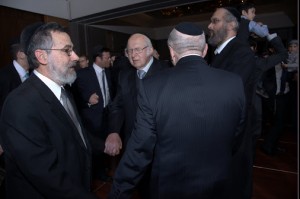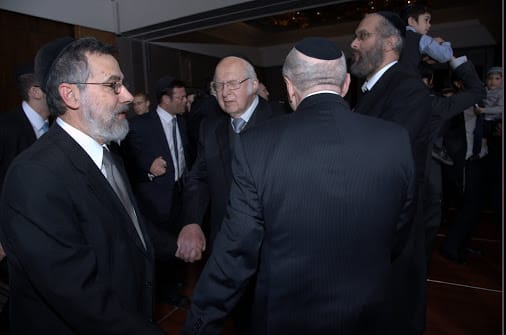 Rav Aharon Lichtenstein, as I knew him, was not merely a giant of Torah, but also a giant of a man. He was a child prodigy—Rav Hillel Zaks, a grandson of the Chafetz Chaim and friend of Rav Aharon from Yeshivas Chaim Berlin, recounted that Rav Aharon stood uniquely above his peers even as a teenager. (In Yeshivas Chaim Berlin, his status as a child prodigy earned him the nickname “the babe,” a moniker which followed him to Yeshiva University.) Rav Aharon’s encyclopedic knowledge was matched by the incisiveness of his analysis, and he was a leading exponent of the Brisker method.
Rav Aharon Lichtenstein, as I knew him, was not merely a giant of Torah, but also a giant of a man. He was a child prodigy—Rav Hillel Zaks, a grandson of the Chafetz Chaim and friend of Rav Aharon from Yeshivas Chaim Berlin, recounted that Rav Aharon stood uniquely above his peers even as a teenager. (In Yeshivas Chaim Berlin, his status as a child prodigy earned him the nickname “the babe,” a moniker which followed him to Yeshiva University.) Rav Aharon’s encyclopedic knowledge was matched by the incisiveness of his analysis, and he was a leading exponent of the Brisker method.
But aside from his genius, Rav Aharon was a man of great humility, kindness, yirat shamayim, and principle. When my father died I was still young, and Rav Aharon offered me great comfort and arranged many of the details of the funeral. He was a man of unsurpassed integrity, both in his intellectual pursuits and in his personal relationships and dealings. I remember in the summer of 1967, Rav Aharon, who was already a Rosh Kollel, playing a game of full-court basketball with other students of the Rav in Onset, Massachusetts. At one point in the game, Rav Aharon turned to me and said, “It is not ethical to play just offense and not defense.” Although his comment was tongue-in-cheek, it reflected his forethought and seriousness with which he undertook his every action.
When I came to know him, Rav Aharon was already the Rosh Kollel of RIETS, but he still attended the Rav’s shiur. His comments during the shiur were always to the point, and the Rav was always very attentive to them. Whenever the Rav was searching for a source, he turned to Rav Aharon, who invariably supplied it. As is well known, Rav Aharon was a proponent of studying literature, because as he once wrote, “the humanities deepen our understanding of man: his nature, functions and duties.” When I was studying Paradise Lost in college, Rav Aharon said to me, “I envy you, because you can read Milton now for the first time.” Once, the Rav explained that the Rambam and Rashi disagree about whether Shir Hashirim is a metaphor for the relationship between the individual soul and God, or a metaphor of the relationship between God and the nation of Israel. Rav Aharon interjected that both meanings can be sustained, just as Spenser’s The Faerie Queene is an allegory with several different layers of meaning. For all his love of poetry, it was the Shir Hashirim within his own soul which animated Rav Aharon’s life, the poetic song within his soul which melded the relationship of both the individual and the Jewish community with God.
A kaleidoscope of images helps capture his unique persona. Rav Aharon retained an eternal youthful quality, which I believe was a product of his unabated sense of discovery and openness to new learning. Upon his Aliyah to Israel, he developed a close relationship with Rav Shlomo Zalman Auerbach, and on the death of Rav Shlomo Zalman, Rav Aharon tore his clothing as a son does for a parent, and as a devoted disciple does for a teacher. In his essay “The Source of Faith is Faith Itself,” we encounter Rav Aharon as one whose faith flowed from the example of his teachers in whom he saw the embodiment of the Jewish tradition—Rav Hutner, the Rav, and Rav Ahron Soloveichik—as well as from the divine encounter that Torah study itself provides. His eloquent words about Rav Ahron Soloveichik apply equally to himself: “I was simply enthralled by what he was—a remarkable fusion of mastery and simplicity, of vigor and humility and, above all, a pillar of radical integrity.” When a new translation of the Rambam’s philosophical magnum opus was published, Rav Aharon approved of the subtle change in title from Guide for the Perplexed to Guide of the Perplexed. The former, he believed, removed the Rambam himself from among the rank of the perplexed, whereas the latter more accurately captures the notion that perplexity is not a contradiction to faith and leadership. This was in keeping with the lesson Rav Aharon learned from his mentors, “that it was not so necessary to have all the answers as to learn to live with the questions.”
I remember that when Rav Aharon left America to join Rav Amital in heading Yeshivat Har Etzion, I did not understand how Rav Aharon was willing to sacrifice his undoubted future prominence as a leader of American Jewry. However, watching from afar, I saw how he and Rav Amital were able to have a significant impact on Israeli society as a whole. In addition to being responsible for introducing the Brisker derech and the thought of the Rav to the yeshivot hesder, Rav Aharon became renowned throughout Israel as a religious leader and thinker of the first rank.
I had the merit to speak to Rav Aharon on the phone one last time just a few weeks ago, as I called to wish him and Dr. Tovah Lichtenstein a Chag Sameach before Pesach and to receive a bracha from him. I will always cherish my memories of him.
The Daf Yomi on the day of Rav Aharon’s passing, Ketubot 77, describes the death of R. Yehoshua ben Levi, the prime student of R. Yehuda Hanasi. Upon his entry into the Garden of Eden, he was heralded by Elijah proclaiming, “Make room for the son of Levi, make room for the son of Levi.” The Talmud explains that R. Yehoshua ben Levi merited his exalted position in the world to come because, in contrast to his peers, he did not disassociate himself from the sufferers of a highly contagious and debilitating disease. Instead, “R. Yehoshua ben Levi attached himself to these sufferers and studied the Torah; for he said, ‘Ayelet ahavim ve-ya’alat chen, a lovely hind and a graceful doe (Mishlei 5:19)—if the Torah bestows grace upon those who study it, would it not also protect them?’” These words of R. Yehoshua ben Levi are a fitting epitaph for Rav Aharon, who was the prime disciple of the R. Yehuda Hanasi of our times, the Rav. Rav Aharon, with his humility, drew close even those that others isolated, those distant from his coterie, and always through the Torah whose grace he radiated. And although this daf marks the end of the chapter Hamadir, the masechta goes on, just as Rav Aharon’s legacy will surely continue through the example of learning, humility and grace he instilled in his extraordinary family and legions of students and admirers.
The words of this author reflect his/her own opinions and do not necessarily represent the official position of the Orthodox Union.

